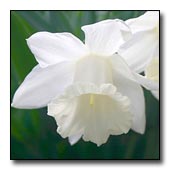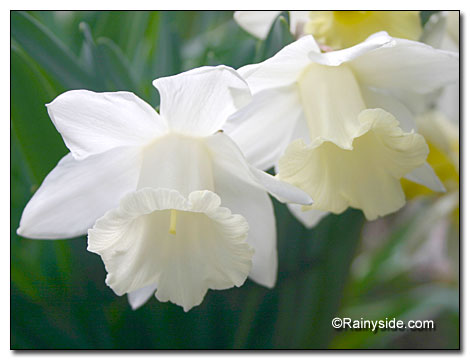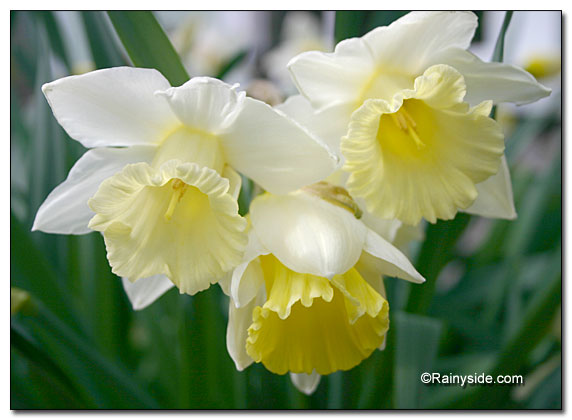Narcissus 'Mount Hood'
DAFFODIL
Family: Amaryllidaceae
Pronounced: nar-SIS-us

Quick Jumps
Growing Guide
Rainy Side Notes
GROWING GUIDE

Origin:
Garden.
Plant Group:
Bulbs.
Hardiness:
Sunset zones: All.
USDA zones: USDA zones: Daffodils will grow in all USDA zones with the exception of southern Florida or warmer areas.
Mature size:
Height: 14-20 inches (35-50 cm).
Flowering period:
March-April.
Flowering attributes:
Stem bears one flower with a yellow perianth and yellow corona. The corona slowly fades to white as the flower ages.
Leaf attributes:
Long, strap-like, green leaves.
Growth habit:
Clump-forming.
Light:
Full sun to partial shade.
Soil:
Humus rich, moist, well-drained soil.
Feeding:
After flowering, apply a low nitrogen/high potash fertilizer. At planting time, toss bone meal or high potash fertilizer into planting hole.
Propagation Methods:
After the leaves dry up, lift bulbs and separate them to increase supply.
Pruning Methods:
Deadhead spent flowers to prevent seed formation so the plant's energy goes into the bulb, not seed production. Do not cut foliage off until it dies down. The foliage helps feed the bulb for next year's flowers; it is important that it stay on the plant until it turns brown. Naturalized in grass, the daffodil foliage needs to ripen for at least six weeks after flowering, before mowing.
Pests and Diseases:
In poorly drained soil, bulb rot may occur.
Rainy Side Notes

Introduced in 1937, this heirloom bulb finds its way into many gardens because it’s a favorite of many gardeners. The plant received the Award of Garden Merit from the Royal Horticultural Society in 1995; Great Plant Picks considers it an outstanding bulb to grow in the Pacific Northwest.
When you grow this large trumpeted daffodil, it's like having two different flowers. The buds open up with white petals and large, lemon yellow trumpets, that slowly fade to cream, and then to white. The blossoms show off their classy good looks no matter what stage of the flower’s maturity, but I like them best when they turn snowy-white.
Daffodils are great plants for deer infested gardens, or rodent infestation—in the ground or above. The pests leave this genus alone. Plant the bulbs six inches deep and no more than six bulbs per square foot. When growing them in containers, you can pack them in tight so long as they are not touching each other. Plant them out in the garden the following year at recommended spacing. The flowers face a southerly direction towards the sun, so you want to plant them with their flower faces towards the viewer.
As with most daffodils, N. 'Mount Hood' is first-rate for forcing and is also a wonderful cut flower. Daffodils last four to six days in a vase. Preservatives do not prolong the flowers; this step is not necessary. The blossoms secrete a mucous from their stems that is unfavorable to other cut flowers. Daffodils can be used alone in the vase or hardened for 12-24 hours in fresh water by themselves, with at least one water change. Rinse stems before combining with other cut flowers.
In fall, plant bulbs four to six inches deep and three to six inches apart. The flowers face a southerly direction towards the sun, so you want to plant them with their flower faces towards the viewer.
Daffodils are harmful if eaten and the bulbs can be a skin irritant.
Photographed in author's garden.

Gardening for the Homebrewer: Grow and Process Plants for Making Beer, Wine, Gruit, Cider, Perry, and More
By co-authors Debbie Teashon (Rainy Side Gardeners) and Wendy Tweton
Copyright Notice | Home | Search | Bulbs

